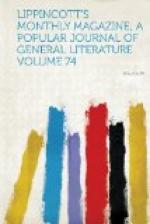“In the Harvard College Library no gas has ever been used, nor any other artificial illuminator to much extent. Neither had any large number of the volumes been exposed to the products of gas-combustion, except for a brief time before they were placed here. The bindings in this library showed very little crumbling, but many covers were breaking at the joints from the shrinking which arises from excessive dryness. In common with many other substances, leather yields moisture to the air much more readily than it receives it from that medium. Cloth bindings showed no decay at all here—very little in any of the libraries, except in the loss of color. It should be stated that the volumes which I examined at Harvard College were generally older than those inspected in the other libraries. There are parchment bindings in each of the libraries hundreds of years old, apparently just as perfect in texture as when first placed upon the shelves of the original owner. The parchment was often worn through at the angles, but there was no breakage from shrinking, the material having been shrunken as much as possible when prepared from the skin. At Harvard College I examined an embossed calf binding stretched on wooden sides which was above a hundred years old. It was in almost perfect preservation, and not much shrunken. This volume, being very large, was on a shelf next the ground floor—a position which it had probably held ever since the erection of the building.




